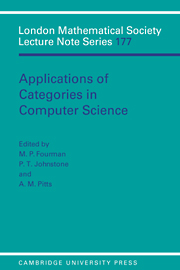 Applications of Categories in Computer Science
Applications of Categories in Computer Science Book contents
- Frontmatter
- Contents
- Preface
- Miscellaneous Frontmatter
- Computational comonads and intensional semantics
- Weakly distributive categories
- Sequentiality and full abstraction
- Remarks on algebraically compact categories
- Dinaturality for free
- Simply typed and untyped lambda calculus revisited
- Modelling reduction in confluent categories
- On clubs and data-type constructors
- Penrose diagrams and 2-dimensional rewriting
- Strong monads, algebras and fixed points
- Semantics of local variables
- Using fibrations to understand subtypes
- Reasoning about sequential functions via logical relations
- I-categories and duality
- Geometric theories and databases
- Partial products, bagdomains and hyperlocal toposes
Geometric theories and databases
Published online by Cambridge University Press: 24 September 2009
- Frontmatter
- Contents
- Preface
- Miscellaneous Frontmatter
- Computational comonads and intensional semantics
- Weakly distributive categories
- Sequentiality and full abstraction
- Remarks on algebraically compact categories
- Dinaturality for free
- Simply typed and untyped lambda calculus revisited
- Modelling reduction in confluent categories
- On clubs and data-type constructors
- Penrose diagrams and 2-dimensional rewriting
- Strong monads, algebras and fixed points
- Semantics of local variables
- Using fibrations to understand subtypes
- Reasoning about sequential functions via logical relations
- I-categories and duality
- Geometric theories and databases
- Partial products, bagdomains and hyperlocal toposes
Summary
Abstract
Domain theoretic understanding of databases as elements of powerdomains is modified to allow multisets of records instead of sets. This is related to geometric theories and classifying toposes, and it is shown that algebraic base domains lead to algebraic categories of models in two cases analogous to the lower (Hoare) powerdomain and Gunter's mixed powerdomain.
Terminology
Throughout this paper, “domain” means algebraic poset – not necessarily with bottom, nor second countable. The information system theoretic account of algebraic posets fits very neatly with powerdomain constructions. Following Vickers [90], it may be that essentially the same methods work for continuous posets; but we defer treating those until we have a better understanding of the necessary generalizations to topos theory.
More concretely, a domain is a preorder (information system) (D, ⊆) of tokens, and associated with it are an algebraic poset pt D of points (ideals of D; one would normally think of pt D as the domain), and a frame ΩD of opens (upper closed subsets of D; ΩD is isomorphic to the Scott topology on pt D).
“Topos” always means “Grothendieck topos”, and not “elementary topos” morphisms between toposes are understood to be geometric morphisms.
S, italicized, denotes the category of sets.
We shall follow, usually without comment, the notation of Vickers [89], which can be taken as our standard reference for the topological and localic notions used here.
Information
- Type
- Chapter
- Information
- Applications of Categories in Computer ScienceProceedings of the London Mathematical Society Symposium, Durham 1991, pp. 288 - 314Publisher: Cambridge University PressPrint publication year: 1992
Accessibility standard: Unknown
Why this information is here
This section outlines the accessibility features of this content - including support for screen readers, full keyboard navigation and high-contrast display options. This may not be relevant for you.Accessibility Information
- 11
- Cited by